Roman Catholic Archdiocese of Chicago
| Archdiocese of Chicago Archidioecesis Chicagiensis | |
|---|---|
 | |
| Location | |
| Country | United States |
| Territory | Counties of Cook and Lake |
| Ecclesiastical province | Chicago |
| Statistics | |
| Area | 1,411 sq mi (3,650 km2) |
| Population - Total - Catholics |
(as of 2013) 6,251,000 2,438,000 (39%) |
| Parishes | 356 |
| Information | |
| Denomination | Roman Catholic |
| Sui iuris church | Latin Church |
| Rite | Roman Rite |
| Established | November 28, 1843 (173 years ago) |
| Cathedral | Holy Name Cathedral |
| Patron saint | Immaculate Conception |
| Current leadership | |
| Pope | Francis |
| Archbishop | Blase J. Cupich[1] |
| Auxiliary Bishops |
Francis J. Kane John R. Manz Joseph N. Perry George J. Rassas Alberto Rojas Andrew P. Wypych |
| Vicar General | Ronald A. Hicks [2] |
| Emeritus Bishops |
John R. Gorman Raymond E. Goedert |
| Map | |
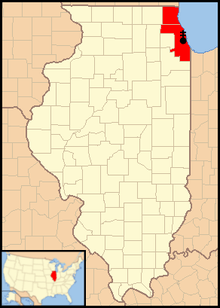 | |
| Website | |
| archchicago.org | |
The Roman Catholic Archdiocese of Chicago (Latin: Archidioecesis Chicagiensis) was established as a diocese in 1843 and elevated to an archdiocese in 1880. It serves the more than 2.3 million Catholics in Cook and Lake counties in Northeastern Illinois, a geographic area of 1,411 square miles (3,650 km2). The archdiocese is divided into six vicariates and 31 deaneries. This local church is headed by His Eminence Blase Joseph Cupich, Cardinal, Archbishop of Chicago, assisted by six episcopal vicars, each responsible for a vicariate (region). The see city for the diocese is Chicago. The cathedral parish for the archdiocese is the Holy Name.
Diocesan history
Arrival of missionaries
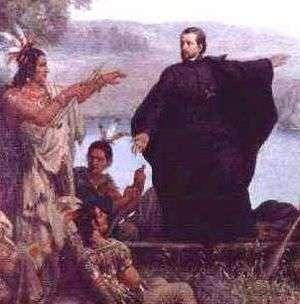
A French Jesuit missionary, the Rev. Jacques Marquette, SJ first explored the area that is now Chicago in the mid-17th century. On December 4, 1674, Father Marquette arrived at the mouth of the Chicago River where he built a cabin to recuperate from his travels. His cabin became the first European settlement in the area now known as Chicago. Marquette published his survey of the new territories and soon more French missionaries and settlers arrived.[3]
First priest
In 1795, the Potawatomi tribe signed the Treaty of Greenville that ceded to the United States a tract of land at the mouth of the Chicago River. There in 1804, Fort Dearborn was erected and protected newly arrived Catholic pioneers. In 1822, Alexander Beaubien became the first person to be baptized in Chicago. In 1833, Jesuit missionaries wrote a letter to the Most Rev. Joseph Rosati, Bishop of Saint Louis and Vicar General of Bardstown, pleading for the appointment of a resident pastor to serve over one hundred professing Roman Catholics living in Chicago. Rosati appointed a diocesan priest, the Rev. John Mary Irenaeus Saint Cyr. Fr. Saint Cyr celebrated his first Mass in a log cabin owned by the Beaubien family on Lake Street, near Market Street, in 1833.[4]
First parish

At the cost of four hundred dollars, Father Saint Cyr purchased a plot of land at what is now the intersection of Lake and State Streets and constructed a church building of 25 by 35 feet (7.6 by 10.7 m). It was dedicated in October 1833. The following year, the Bishop of Vincennes visited Chicago, where he found over 400 Catholics with only one priest to serve them. The bishop asked permission from Bishop Rosati to send Fathers Fischer, Shaefer, Saint Palais, Dupontavice, and Joliet from Vincennes to tend to the needs of the Chicago region. In 1837, Fr. Saint Cyr was allowed to retire and was replaced by Chicago's first English-speaking priest, the Rev. James Timothy O'Meara. Father O'Meara moved the church built by Fr. Saint Cyr to what is now the intersection of Wabash Avenue and Madison Street. When Fr. O'Meara left Chicago, Saint Palais demolished the church and replaced it with a new brick structure.[5]
Diocesan establishment
The First Plenary Council of Baltimore concluded that the Roman Catholic population of Chicago was growing exponentially and was in dire need of an episcopal see of its own. With the consent of Pope Gregory XVI, the Diocese of Chicago was canonically erected on November 28, 1843. In 1844, William Quarter of Ireland was appointed as the first Bishop of Chicago. Upon his arrival, Quarter summoned a synod of 32 Chicago priests to begin the organization of the diocese.[4] One of Quarter's most important achievements was his successful petitioning for the passage of an Illinois law in 1845 that declared the Bishop of Chicago an incorporated entity, a corporation sole, with power to hold real and other property in trust for religious purposes.[6] This allowed the bishop to pursue large-scale construction of new churches, colleges and universities to serve the needs of Chicago's Roman Catholic faithful. After four years of service as Bishop of Chicago, Bishop Quarter died on April 10, 1848.[7]
Fire of 1871

The church lost nearly a million dollars in church property in the Chicago fire of 1871, leading to administrative instability for decades.[6]
Archdiocese establishment
The southern section of the state of Illinois split from Chicago diocese in 1853, becoming the Diocese of Quincy. The Quincy diocese was renamed the Diocese of Alton in 1857, and eventually became Diocese of Springfield. The Diocese of Peoria was established in 1877 from another territorial split from the Chicago diocese.[6]
From 1844 to 1879, the diocesan bishop of the Diocese of Chicago held the title Bishop of Chicago. With the elevation of the diocese to an archdiocese in 1880, the diocesan bishop held the title Archbishop of Chicago. Since 1915, all Archbishops of Chicago have been honored in consistory with the title of Cardinal Priest and membership in the College of Cardinals. The archbishops also have responsibilities in the dicasteries of the Roman Curia. All but two diocesan bishops were diocesan priests before assuming the episcopacy in Chicago. Two came from religious institutes: the Society of Jesus (James Van de Velde) and the Missionary Oblates of Mary Immaculate (Francis George).[4]
Our Lady of the Angels fire
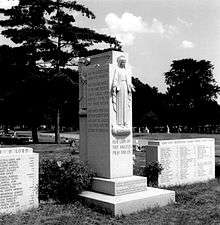
The Our Lady of the Angels School Fire occurred at the Our Lady of Angels School on December 1, 1958, in the Humboldt Park area of western Chicago. The school, which was operated by the Archdiocese, lost 92 students and three nuns in five classrooms on the second floor.
Archbishop's Residence
The Archbishop's Residence at 1555 North State Parkway is the official home of the Archbishop of Chicago and is listed on the National Register of Historic Places. Built in 1885 by the Most Rev. Patrick Feehan, first Archbishop of Chicago, the Archbishop's Residence is a three-story, red brick building and is one of the oldest structures in the Astor Street District, according to the Landmarks Preservation Council.
When Pope John Paul II visited Chicago in 1979, he became the first Pontiff to stay at the residence. Two previous popes stayed at the residence as cardinals: Cardinal Eugenio Cardinal Pacelli, who became Pope Pius XII; and Cardinal Giovanni Montini, who became Pope Paul VI.
Before the establishment of the Archbishop's Residence, the Bishops of Chicago were in residence at a home on LaSalle Street and North Avenue.
All archbishops of Chicago lived at the mansion until the appointment of the ninth and current archbishop, Blase Cupich, who chose to live at Holy Name Cathedral.
Bishops
Diocesan bishops
Bishops
- William J. Quarter (1844–1848)
- James Oliver Van de Velde, SJ (1848–1853)
- Anthony O'Regan (1854–1858)
- James Duggan (1859–1880)
Archbishops
- Patrick Augustine Feehan (1880–1902)
- James Edward Quigley (1903–1915)
- Cardinal George Mundelein (1915–1939)
- Cardinal Samuel Stritch (1939–1958)
- Cardinal Albert Gregory Meyer (1958–1965)
- Cardinal John Cody (1965–1982)
- Cardinal Joseph Bernardin (1982–1996)
- Cardinal Francis George, OMI (1997–2014)
- Cardinal Blase J. Cupich (2014–present)
Coadjutor bishop (who did not become diocesan bishop)
Current auxiliary bishops
- See Auxiliary bishop
- John R. Manz (March 5, 1996 – present)
- Joseph N. Perry (June 29, 1998 – present)
- Francis J. Kane (March 19, 2003 – present)
- George J. Rassas (February 2, 2006 – present)
- Andrew Peter Wypych (August 10, 2011 – present)
- Alberto Rojas (August 10, 2011 – present)
Retired auxiliary bishops
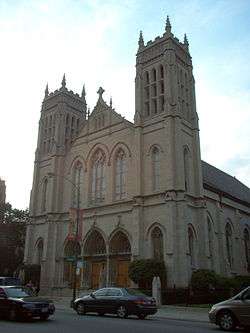
Deceased auxiliary bishops
- Alfred Leo Abramowicz
- Edwin Michael Conway
- Michael Dempsey
- Nevin William Hayes, O. Carm.
- William David O'Brien
- Bernard James Sheil
- Thad J. Jakubowski
- Timothy Joseph Lyne
Bishops who once were priests of the archdiocese
The following men began their service as priests in Chicago before being appointed bishops elsewhere (this includes some who served here as auxiliary bishop):
- Living
- Edward Braxton, Bishop of Belleville, Illinois
- Wilton D. Gregory, Archbishop of Atlanta
- James Patrick Keleher, Archbishop Emeritus of Kansas City in Kansas
- Gerald Frederick Kicanas, Bishop of Tucson
- Jerome Edward Listecki, Archbishop of Milwaukee
- Thomas J. Paprocki, Bishop of Springfield in Illinois
- Gustavo García-Siller, M.Sp.S., Archbishop of San Antonio in Texas
- Edward James Slattery, Bishop of Tulsa
- John George Vlazny, Archbishop Emeritus of Portland in Oregon
- Plácido Rodriguez, CMF, Bishop of Lubbock
- Robert Barron, Auxiliary Bishop of Los Angeles
- Deceased
Priests
- Donald Martin Carroll, Roman Catholic priest, appointed bishop of the Roman Catholic Diocese of Rockford in 1956, but resigned before his consecration due to ill health
- Andrew Greeley, Roman Catholic priest, writer, sociologist, journalist
- Reynold Henry Hillenbrand, Roman Catholic priest, liturgist
- Michael Pfleger, Roman Catholic priest, social activist
Structure of the archdiocese
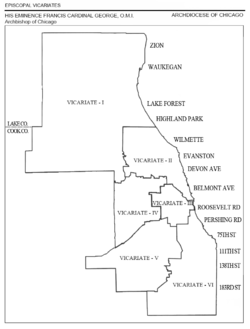
Administration
The Archdiocese Pastoral Centers are Archbishop Quigley Center, 835 North Rush Street and Cardinal Meyer Center, 3525 South Lake Park Avenue, both in Chicago.
Administrative Council to the Archbishop
Ronald Hicks, Vicar General
Stephen Kanonik, Moderator of the Curia
Jeffery Grob, Chancellor
Francis J. Kane, Auxiliary Bishop, Episcopal Vicare, Vicariate II
John R. Manz, Auxiliary Bishop, Episcopal Vicar, Vicariate IV
Joseph N. Perry, Auxiliary Bishop, Episcopal Vicar, Vicariate VI
George J. Rassas, Auxiliary Bishop, Episcopal Vicar, Vicariate I
Alberto Rojas, Auxiliary Bishop, Episcopal Vicar, Vicariate III
Andrew P. Wypych, Auxiliary Bishop, Episcopal Vicar, Vicariate V
Thomas A. Baima, Vice Rector for Academic Affairs, University of St. Mary of the Lake / Mundelein Seminary
Michael M. Boland, Director, Catholic Charities
Betsy Bohlen, Chief Financial Officer
George Puszka, Director, Finance
Christopher J. Cannova, Department of Personnel Services
Peter de Keartry, Interim-Director, Department of Human Services
Richard P. Hynes, Director, Department of Parish Life and Formation
Jim Rigg, Superintendent, Archdiocesan Board of Catholic Education
Departments
Departments, agencies and offices include:
|
|
Office of Catholic Schools

The Office of Catholic Schools operates, manages, and supports diocesan and Catholic primary and secondary schools. Catholic education in the Chicago area began on June 3, 1844 with the opening of a boys' school. Chicago parochial schools served various ethnic groups, including Irish, Germans, Poles, Czechs and Bohemians, French, Slovaks, Lithuanians, Puerto Rican Americans, African Americans, Italians, and Mexicans. Many local nuns living in convents established and operated Catholic schools.
The school construction boom ended when Cardinal John Cody, archbishop at the time, decided to limit construction of Catholic schools in Lake County and suburban areas in Cook County. Due to changes in demographics, the archdiocese has since closed more than half of its urban schools since 1966.[9]
Between 1984 and 2004, the Office of Catholic Schools closed 148 schools and 10 school sites.[10] An August 27, 2015, article in the Chicago Tribune refers to the Archdiocese of Chicago Office of Catholic Schools as the largest private school system in the United States. As of 2015, the Superintendent of Catholic Schools is Jim Rigg, Ph D.[11]
Respect Life Office
Cardinal Francis George established the Respect Life Office within the archdiocese. "It promotes the cause of life through advocacy and prayer. It has available educational resources, a speakers bureau and sponsors annual conferences, retreats and rallies for adults and youth. The Office also maintains Project Rachel, a program of reconciliation for those who participated in an abortion; and the Chastity Education Initiative, which serves youth and young adults of the Archdiocese, inspiring them to make positive choices about the gift of human sexuality."[12]
The Respect Life Office has coordinated several pro-life initiatives in the Chicago area. These include the local 40 Days for Life[13] campaign, annual trip to the March for Life in both Chicago and Washington, DC for college and high school students.[14]
Seminaries
- University of Saint Mary of the Lake (Mundelein Seminary) - major seminary
- St. Joseph College Seminary - undergraduate seminary program of the Archdiocese of Chicago (affiliated with Loyola University Chicago)
- Archbishop Quigley Preparatory Seminary -high-school seminary (closed 2007)
Province of Chicago

- Diocese of Belleville
- Diocese of Joliet in Illinois
- Diocese of Peoria
- Diocese of Rockford
- Diocese of Springfield in Illinois
See also
- Category:Roman Catholic Archdiocese of Chicago
- The Catholic New World, the official newspaper of the Archdiocese
- Our Lady of Perpetual Help (Glenview, Illinois), one of the largest parishes in the Archdiocese
- Polish Cathedral style churches of Chicago
- St. Anne Catholic Community, another of the largest parishes in the Archdiocese
- Ukrainian Catholic Eparchy of Chicago
- Syro-Malabar Catholic Diocese of Saint Thomas the Apostle of Chicago
- List of the Roman Catholic bishops of the United States
- List of the Roman Catholic cathedrals of the United States
- List of the Roman Catholic dioceses of the United States
- United States Conference of Catholic Bishops
- Shrine of Christ the King, Sovereign Priest; in Chicago, Illinois[15]
References
- ↑ Joshua J. McElwee (2014-09-21). "Exclusive: Chicago's new archbishop talks about 'stepping into the unknown'". National Catholic Reporter. Retrieved 2014-09-22.
- ↑ "Archbishop Blasé J. Cupich announces the appointment of Rev. Ronald Hicks as Vicar General of the Archdiocese of Chicago" (Press release). Archdiocese of Chicago. November 21, 2014. Retrieved March 3, 2016.
- ↑ Monet, J. (1979). "Marquette, Jacques". Dictionary of Canadian Biography. University of Toronto/Laval University. Retrieved March 3, 2016.
- 1 2 3 Melody, John (1908). "Archdiocese of Chicago". Catholic Encyclopedia. New York: Robert Appleton Company. Retrieved March 3, 2016.
- ↑ "Father O'Meara biography". St. Dennis Church. Archived from the original on March 10, 2007. Retrieved April 29, 2006.
- 1 2 3 Avella, Steven M. (2005). "Roman Catholic Archdiocese of Chicago". Encyclopedia of Chicago. Chicago Historical Society/Newberry Library. Retrieved March 3, 2016.
- ↑ "Bishop William Quarter (1806-1848)". Offaly Historical & Archaeological Society. September 2, 2007. Archived from the original on January 5, 2006. Retrieved March 3, 2016.
- ↑ "Departments and Agencies" (shtm). Archdiocese of Chicago. Retrieved April 29, 2006.
- ↑ Skerrett, Ellen (2005). "Catholic School System". Chicago Historical Society/Newberry Library. Retrieved March 3, 2016.
- ↑ Simons, Paul. "Closed School History: 1984-2004" (PDF). Archdiocese of Chicago. Retrieved March 3, 2016.
- ↑ Crosby, Rachel (August 27, 2000). "Chicago Catholic Schools names new superintendent". Chicago Tribune. Retrieved March 3, 2016.
- ↑ "Respect Life Office". Archdiocese of Chicago. Retrieved March 3, 2016.
- ↑ DeFiglio, Pam (October 12, 2008). "Crowd kicks off '40 Days for Life' prayer vigil". Catholic New World. Retrieved March 3, 2016.
- ↑ ""March for Life Chicago" to Mark Respect Life Month Activities" (Press release). Archdiocese of Chicago. January 16, 2014.
- ↑ "Information, Schedule & Directions". Shrine of Christ the King. Retrieved March 3, 2016.
Further reading
- Coughlin, Roger J. Charitable Care in the Archdiocese of Chicago (Chicago: The Catholic Charities, 2009)
- Dahm, Charles W. Power and Authority in the Catholic Church: Cardinal Cody in Chicago (University of Notre Dame Press, 1981)
- Faraone, Dominic E. "Urban Rifts and Religious Reciprocity: Chicago and the Catholic Church, 1965-1996." (2013, PhD, Marquette University); Bibliography pages 359-86. online
- Garrathan, Gilbert J. The Catholic Church in Chicago, 1673-1871 (Loyola University Press, 1921)
- Greeley, Andrew M. Chicago Catholics and the struggles within their Church (Transaction Publishers, 2011)
- Hoy, Suellen. Good Hearts: Catholic Sisters in Chicago’s Past (University of Illinois Press, 2006)
- Kantowicz, Edward R. Corporation Sole: Cardinal Mundelein and Chicago Catholicism (University of Notre Dame Press, 1983)
- Kantowicz, Edward R. The Archdiocese of Chicago: A Journey of Faith (Ireland: Booklink, 2006)
- Kelliher, Thomas G. Hispanic Catholics and the Archidiocese of Chicago, 1923-1970 (PhD Diss. UMI, Dissertation Services, 1998)
- Kennedy, Eugene. This Man Bernardin (Loyola U. Press, 1996)
- Koenig, Rev. Msgr. Harry C., S.T.D., ed. Caritas Christi Urget Nos: A History of the Offices, Agencies, and Institutions of the Archdiocese of Chicago (2 vols. Catholic Bishop of Chicago, 1981)
- Koenig, Rev. Msgr. Harry C., S.T.D., ed. A History of the Parishes of the Archdiocese of Chicago. (2 vols. Catholic Bishop of Chicago, 1980)
- McMahon, Eileen M. What Parish Are You From?: A Chicago Irish Community and Race Relations (University Press of Kentucky, 1995)
- Neary, Timothy B. "Black-Belt Catholic Space: African-American Parishes in Interwar Chicago." US Catholic Historian (2000): 76-91. in JSTOR
- Parot, Joseph John. Polish Catholics in Chicago: 1850-1920: a Religious History (Northern Illinois University Press, 1981.)
- Reiff, Janice L. et al., eds. The Encyclopedia of Chicago (University of Chicago Press, 2004) online
- Sanders, James W. The education of an urban minority: Catholics in Chicago, 1833-1965 (Oxford University Press, 1977)
- Shanabruch, Charles. Chicago's Catholics: The evolution of an American identity (Univ of Notre Dame Press, 1981)
- Skerrett, Ellen. "The Catholic Dimension.” in Lawrence J. McCaffrey et al. eds. The Irish in Chicago (University of Illinois Press, 1987)
- Skerrett, Ellen. Chicago’s Neighborhoods and the Eclipse of Sacred Space (University of Notre Dame Press, 1994)
- Skerrett, Ellen. et al. eds., Catholicism, Chicago Style (Loyola University Press, 1993)
- Skok, Deborah A. More Than Neighbors: Catholic Settlements and Day Nurseries in Chicago, 1893-1930 (Northern Illinois University Press, 2007)
- Wall, A.E.P. The Spirit of Cardinal Bernardin (Chicago: Thomas More Press, 1983)
External links
| Wikimedia Commons has media related to Roman Catholic Archdiocese of Chicago. |
Coordinates: 41°53′46″N 87°37′40″W / 41.8960°N 87.6277°W
